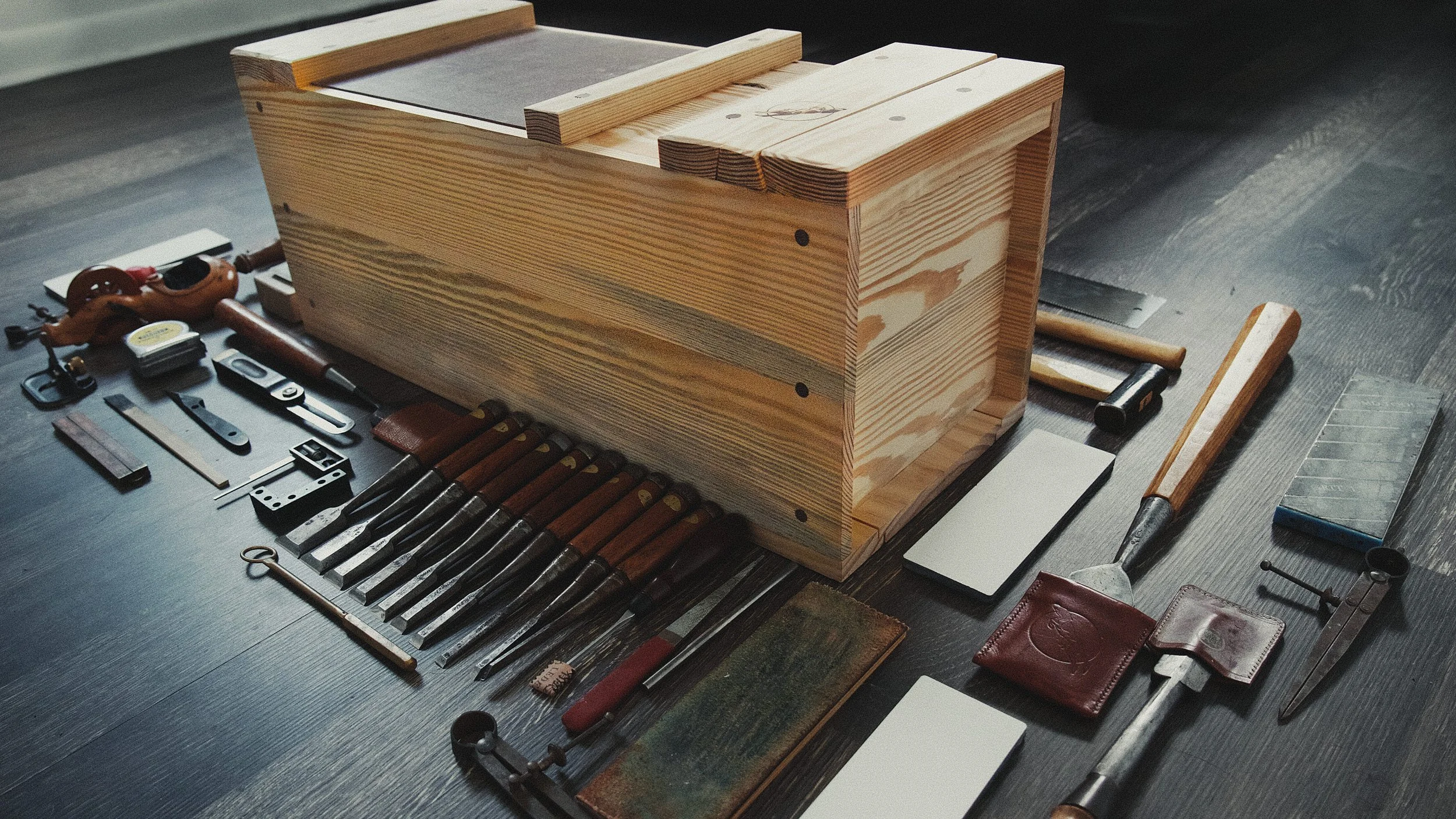I really want to call this a traditional Japanese tool chest. Truth be told, while the YouTube video is titled that way, there is little that is traditional about this. Yes, it holds a variety of traditional tools. However, I designed this tool chest in an effort to be approachable and affordable to the average person. Notwithstanding that, it was wildly difficult and annoying to build. It almost felt that buy trying to simply the build that I kept managing to mess things up along the way.
Japanese Tool Chest made with construction grade yellow pine
Japanese Tool Boxes and Tool Chests are very humble in their origin. They are primarily made from construction grade materials that craftsmen had available to them and they carry a variety of hand tools as well as sharpening equipment and layout tools. They’re practical. Supposed to be used on the job site or on the floor in a home where a shokunin would be crafting shoji screens. They appear to be vastly different from Dutch tool chests or their western counterparts that are most often embellished heavily and painted, some even made with decorative trim.
My idea in this video was to make a humble tool chest to house my tools when I travel and to keep them sort of condensed in the shop. I looked to the Anarchist Tool Chest by Christopher Schwarz as inspiration, but clearly I did not do nearly as much research and did not put the thoughtfulness into how the tools ultimately laid in the chest itself. The result is a functional box, that houses my tools, but that does not really comport to the idea of the chest itself having the tools inside while I pick what I need out of it and then put it back in its place. Instead, I designed it with various trays that need to be lifted out and while that does have its place and it is useful to an extent, it’s not the “ultimate Japanese tool chest” that I dreamed of making. C’est la vie.
The unsung hero of affordable dado stacks the DIABLO Stacked Dado Set
As part of The Home Depot PROspective I do have to highlight two of the unsung tools in this build. First, the DiABLO Stacked Dado Set, ringing in at under $100 was a godsend. I’ve cut dados by hand or used multiple passes with a rip blade and well… it’s not ideal. This dado stack is omni-directional and it cut impressively clean and accurate dados. It’s also worth mentioning that it has a really helpful diagram included in the packaging that dials things in to 1/32”. I had some odd thickness for my case work and the chart allowed me to cut deadly accurate dados that only required just a touch of kigoroshi to make it fit perfectly. For more on that, watch the video.
DIABLO Cross Cut Blade in Action
Now I know a salty old woodworker is going to roll his eyes into the back of his brain when I say this… but I don’t typically switch out rip blades and cross cut blades. Candidly, I’m usually just roughing stuff out on machines and most of my refining work is done by hand so this always seemed like an annoying unnecessary step. However, when DIABLO sent me this high tooth cross cut blade I realized, in devastating fashion, that I’ve been wrong this whole time.
The end result of white pine with the DIABLO cross cut blade
The high tooth count makes for an almost finish ready surface immediately off the saw blade. I don’t do a ton of sanding but just from feel, it appeared to have the look of a 220-320 grit surface off the bat. And as a test, of my own laziness as well as the blade itself, I left it in for some small rip cuts and honestly, it still worked. It was a fair bit slower but it still handled the job perfectly fine. It was an inexpensive and practical option that I’m a bit embarrassed that I hadn’t handled sooner.
Both of these tools are available at Home Depot. The dado stack is linked here: https://homedepot.sjv.io/JrjkWa. Whereas the cross cut blade is linked here: https://homedepot.sjv.io/BXG51L. Neither of these tools are remarkably expensive and they are almost guaranteed to elevate your work. In the case of the dado stack, I can testify that I’ve used vastly more inexpensive options and been extremely disappointed. In fact, one particular option within a couple uses lost a carbide tooth which is not only bad for work but also potentially dangerous to the user.
Be sure to check out the video to see not only the tools in action but also the various ups and downs of this project. I’ll say that while this all ended up coming together just fine, at one point it felt as though someone dropped a hex on this project as the mini-fails just kept a rolling. Should make for a fun ride.
Let me know what you think!





